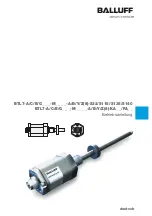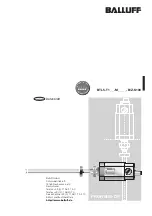
1
ON
1 2
ON
1 2
XRF-1
50
121
23
5
50
121
23
5
50
125
23
106
22
ON
1 2
50
125
23
106
22
ON
1 2
50
121
23
4.2
5.7
4.2
22
106
50
121
23
5.7
4.2
4.2
22
106
LED 1
LED
Wireless single channel signal transmission system for safety edges
Original operating instructions
Intended use: Monitoring safety edges on doors and gates
1
Safety instructions
ENGLISH
404169C
07/20
Transmitter (Tx)
Receiver (Rx)
• Read these operating instructions thoroughly before putting the device into
operation and keep them for future reference.
• The assembly, commissioning, modifications and extensions may only be comple-
ted by an experienced electrician.
• Before commencing work, remove the power supply from the device/installations!
• During the operation of electrical components
– e. g. in the case of a short circuit hot and ionised gases can be
emitted
– protection covers must not to be removed.
• Pay attention to all local relevant electrical safety regulations.
• Disregard of the safety regulations can cause death, severe injuries or extensive
damage.
• Devices that are classified as Category 2 according to EN ISO 13849-1 must be
tested regularly – at least once per cycle.
• It is the responsibility of the equipment manufacturer to carry out a risk assess-
ment and to install both the detector and the equipment in compliance with
applicable national and international regulations and safety standards, as well as
the Machinery Directive 2006/42/EC, should this apply.
Receiver
Tx1
Tx2
Before commencing the installation or assembly complete the following safety
precautions:
• Check the voltage data on the label of the switching device.
• Ensure that the device/installations can not be switched on.
• Determine that the power supply is disconnected.
• Protect the device with a housing against contamination or aggressive
environments.
• Connect all operating and switching voltages to the same fuse.
• Connect the operating voltage to the same circuit as the industrial door controller.
• Disconnect device from mains in the event of a fault.
This equipment is not suitable for use in locations where children are likely to be
present.
Limited protection against accidental contact!
Receiver
Output
1
Transmitter Tx1
(input 1) corresponds to receiver output
Transmitter Tx2
(input 1) corresponds to receiver output
Further transmitters with separate manuals
Battery
CR2450N
Push button
DIP-
Switch
Space
to open cover
Space
to open cover
LED SYS
DIP-switch
2
Common application
Push button






















